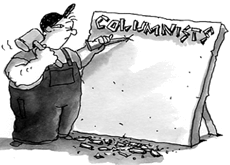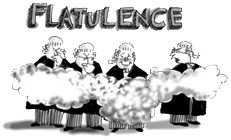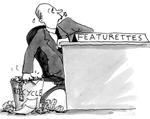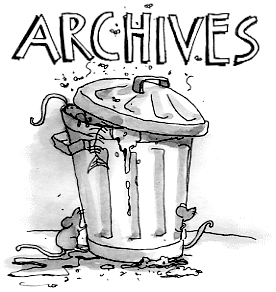The media's adulterous relationship with justice
 Judges •
Judges •  Wednesday, July 6, 2011
Wednesday, July 6, 2011 Keynote address in Adelaide by the editor of Justinian to the 21st biennial conference of District and County Court judges ... Journalists and judges have so much in common, so why is there such distrust?
INTRODUCTION
I too would like to acknowledge the traditional owners of this country, as well as keeping a respectful eye on the holders of fee simple - Conrad Hilton and his heirs and successors, the Downers, the Murdochs, the Bonythons.
Attorney General, Chief Judge, honourable judges, ladies and gentlemen ...
Thank you for inviting me to speak this morning.
It's entirely appropriate to have a journalist come and talk to judges and tell them a thing or two.
At the outset I'd like to say that there is much journalists and judges have in common.
We both deal with thin slices of the truth.
We move from case to case, from story to story in our seamless processing and packaging of bite sized chunks of human misery.
We have so much to share ... yet there is so much distrust and misunderstanding.
There is one important difference. There is no appeal from a journalist. I like to think the reason for this is the same reason the courts here have decided barristers cannot be sued for negligence in court.
It's disruptive, upsetting, distracts you from pursuit of income and looks bad.
When I was working as a young journalist for the Financial Review in the Canberra press gallery there was a fellow who worked at the Treasury who said he had a hot story for me.
He said that Sir William Gunn, the chairman of the Wool Board and a governor of the Reserve Bank was stealing the country's gold reserves.
This sounded interesting, but for various reasons, one of which was there was absolutely no proof, we did not publish this information.
The source kept ringing me and complaining that I hadn't written the story. I enquired about him with others. Was he mad, was he trustworthy?
As a result he made a complaint to the ethics committee of the Australian Journalists Association that I had spoken about him, with other people. I certainly had inquired about him, but not revealed he was a source of information, or even misinformation.
I must add that this Treasury officer is now in jail, having been found guilty of shooting and killing the ACT Police Commissioner, Colin Winchester.
Anyway, I was anxious about my forthcoming appearance before the journalists' ethics committee. I spoke about my anxiety to a colleague on the Financial Review who was closely involved with the journalists' union.
He was most encouraging. What he said still resonates with me, "Don't worry about it Richard. I've got the numbers on the ethics committee."
This was a great comfort. Later I came to understand this is the way appeal courts work, including the High Court, where the magic number is four.
* * *
This morning I have been allocated three-quarters of an hour, which strikes me as quite a long time to sit still and listen to someone in a five-second-grab sort of world. It is the time Geoffrey Robertson would take to answer one question. I quite understand if anyway wants to stretch their legs or have a smoke.
The topic sounds exciting, Court in the Act - the media's adulterous affair with justice.
That really is a cover all for a peroration about the life of a court reporter ... the sort of things journalists want ... judges' responses to journalists and the media, and why they might not always be sympathetic ... and finally the incredible forces of creative destruction that are wrecking havoc on the media and the law alike.
* * *
LIFE OF A COURT REPORTER
Ever since newspapers became popular organs of propaganda and information courts have provided some of the great human interest stories of journalism.
On some days court reports make up a fifth of all news stories in our daily papers.
Coverage of courts is a vital component of the news cycle. Newspapers, radio and TV news bulletins are as dependant on court rooms as they are on parliaments and politicians for a stream of stories.
Courts are a vital window on the human condition, and reporting what goes on there is a big part of our democracy.
How then does the court reporter function today in an era of diminished newsrooms and economically fraught media business models - particularly newspapers?
I thought it might be worthwhile for you to have some idea as to how it operates on the other side of the wall.
Generally, this is the process for reporters who have the courts round, at least the ones I have spoken to ...
And it starts the night before the daily flit from court to court commences, when a short list of potential cases to cover has been compiled from the next day's court lists.
By 9am they are on the phone to judges' associates asking for a brief description of those cases and trying to whittle down the options about what to report.
Once that is decided they email or ring their chief of staff with the likely starters.
This may involve covering three cases in a day. If one case is important they stay with it. With the others it's a process of ducking in and out of the courtroom to pick up slices of addresses, or evidence or struggling to get hold of transcript.
It's a juggle of competing priorities.
During the morning tea break they file for the website of the newspaper, (maybe also the same for radio or TV reporters).
During the lunch break another update has to be filed for the online coverage.
Also, at lunch time, in between going through their notes and filing a story, the reporters, at least on the SMH have to file a news listing for the editorial conference at 2pm.
So by 2 o'clock they need to have a fair idea of where the relevant case is heading and how it is to be written up.
Then there's the final newspaper or news bulletin deadline at 6pm.
For newspaper reporters generally the best bits are kept for the hard copy editions. The reason being that if a reporter files any exclusive angle or extra information in the online updates it runs the risk of being snaffled by the opposition.
The Sydney Morning Herald, one of the biggest papers in the country, has only two court reporters. In its heyday it has six people covering courts, with specialist reporters in different courts, including the industrial court.
Frankly, nowadays it's a battle to cover the Supreme and District Court. The Local Court is largely ignored.
Of course, AAP provides additional straight coverage. However, it only has two court reporters in Sydney, plus a cadet in the second half of the year.
Each day the court reporters give the news desk a status update of about 100 cases. They also keep electronic diaries of about 300 cases at any one time. These are cases that are in the system and on which they are keep an eye as to their progress.
Each night the reporters go through the court lists for the following days and the whole process starts again.
* * *
The biggest gripe reporters hear from judges is about "inaccuracy", or as my old Maths teacher used to say "carelessey".
However, quite frequently, this is a direct result of not having access to the information before the court.
If a judge denies access to the documents that are in evidence then the reporters are sitting in court hearing only half the conversation.
In these circumstances accuracy is dependent on the judge's attitude to access. Judges who deny reasonable access cannot fairly complain about inaccuracy.
Not all courts are the same. The Federal Court is by far the most generous with access. Pleadings and affidavits on file are available to the press.
In fact, sometime this year the contents of Federal Court files will be going online. They will be accessible to the world.
With the Supreme and District Courts at least it is a daily case by case, judge by judge struggle for information.
The outcome is inconsistency. Some judges are great, they understand what the media needs and give quick responses to requests for information.
Others detest the media and journalists and just say no all the time.
Among the most important things that reporters want is the statement of claim with the pleadings. Under the Court Information Act, which comes into force soon in NSW, they can't have it until the final version is before the court after the hearing has commenced.
We think this is ridiculous. It's a public document, filed in a public institution, commencing public proceedings and it's necessary to get hold of it to properly background the case.
As a result of the tightening of editorial budgets and newsrooms being run with skeleton crews there is an increased demand for transcript.
Two reporters covering the entire court system for one newspaper is not going to go far. One way to bridge the gap is to get transcript, but its availability varies from jurisdiction to jurisdiction.
In South Australia it's quite good, except when there has been a suppression order made. Untangling the suppressed bits from the unsuppressed bits becomes a problem.
In NSW transcript is available to the media in high profile cases, such as the Kelli Lane murder trial, the Standen trial, and the big terror trial at Parramatta.
Court information officers find that there are more and more requests for transcript because journalist can no longer sit through all the cases that need to be covered.
The response we get is - well the courts are open, if you sit there with a notebook all day you can get the story. Your lack of resources is not a court problem.
* * *
One of the ways where some District-County Courts could strive for improvement is to get as many judgments as possible on line.
Because a lot of your judgments are ex-temp they have to be transcribed and checked. But there is still a lack of judges with an electronic awareness.
In NSW there are only about about five District Court judges who make a religious effort to get judgments or sentencing remarks posted on line.
Then there is the vexed issue of suppression orders. The media think there are too many and given too reflexively.
What would be nice to know is the reason for a suppression order and notification if and when the order is lifted.
The court information officer is dependent on information about suppression orders flowing from associates.
Sometimes the associates don't pass on the news and no one even knows there is a suppression order.
There is some flirtation with a national suppression order scheme. I don't think it has got very far. How is the database to be managed and who has access to this secure website? - are key issues.
One of the worrying elements of the proposal is that all suppression orders would have a national reach. If a magistrate in Launceston made a suppression order it would affect the Northern Territory News in Darwin.
Maybe that would be no bad thing if the NT News was subject to a permanent and all encompassing suppression order.
And why hasn't the use of social media, or as I prefer to call it, open media, been used by the courts, at all, let alone effectively.
As far as I'm aware the Supreme Court of Victoria's information officer is the only court official using Twitter.
Most half decent journalists have a Twitter account. Courts should be using this form of open media to post reports or papers by judges or links to judgments or discussion papers.
The engagement is possible without prejudicing judicial rectitude.
This is a far more connected world and I think the courts can and should connect better and more … open yourselves up and feel the freshness of the feedback.
When I speak to court information officers they say the media has plenty of reasonable access.
When I speak to court reporters they say they do not have enough timely access, particularly so TV reporters who need vision, CCTV footage and the like.
There is a disconnect between the service providers and the consumers.
* * *
WHAT'S IT LIKE ON THE OTHER SIDE?
What do we hear from judges?
The media gets it wrong, it sensationalises without knowing all the facts, particularly with sentencing decisions, it has driven a political response for harsher penalties and it panders to a populist law and order agenda, it attacks judges who are unable to defend themselves, and it generates fear in the breasts of law abiding Australians.
You also may have noticed a certain media satisfaction whenever judges slip from grace.
Most recently we had acting justice Roderick Howie running foul of the traffic at 9.30 in the morning with a blood alcohol of 0.121.
The headlines relished the moment, made all the more poignant because Howie wrote the guideline judgment on high end drink driving ...
"Judge misses drink driving court date to go on holiday" - said The Sydney Morning Herald.
"Judge may do time over drink driving," declared The Australian.
"Welcome at the Bar - drunken judge a law unto himself behind the wheel," said The Daily Telegraph.
The attacks on Justice Jeff Shaw after his bingle in Birchgrove, you might remember, were pretty outrageous.
When he ultimately went off to the Sydney Clinic for treatment, a journalist from The Australian by the name of Ean Higgins inveigled his way into Shaw's room and wrote this low-down piece:
"Jeff Shaw is used to a big world of excellent food and wines, sports cars, a stately house with expensive views, and a politico-judicial circle of friends including ministers, silks and fellow judges.
Yesterday his universe was a small, rather depressing room in The Sydney Clinic, from which he took a break to eat his lunch with a dozen or so other patients in a Spartan dining hall with plastic table tops."
Nothing is more fun than for a newspaper photographer to pop-up at the Australian Bar Association Conference, specially if it is being held somewhere like Florence and snap Tubby Callinan in his Panama hat, clutching a glorious Campari against the backdrop of the Villa Medici.
The Telegraph published a bold story about judges with photos of Jeff Shaw, Judge Ian Dodd (who had a sleep apnea problem) and Justice Vince Bruce, captioned "drunk, drowsy and depressed".
It's important to note that these human failings are quite acceptable in journalists, maybe even compulsory, but are out of bounds for judges.
Slow judges are always a prize media catch and that is fair enough. As it was also quite legitimate to report that 66 judges were up to seven years behind in lodging tax returns.
Justice Ron Sackville, the then head of the Judicial Conference, reassured everyone that "94 percent of judges and magistrates were law abiding".
A new field of forensic enquiry was thereby opened up.
And there's been the more recent round of reports accompanying the spectacle of magistrates pleading the mental illness card begging before parliament to keep their jobs.
If magistrates had decent judges' pensions instead of contributory super much of this humiliation could be avoided. As it is the poor devils still have to pay the bills so they have to fight on.
I'm told the federal magistrates are launching a chapter 3 case in the High Court over this very issue.
As it is the Judicial Commission's findings and the appearances before parliament ushered in a torrent of informal complaints about those two magistrates from upset parties who had appeared before them.
Indeed, some of the complaints concerned unpleasant behaviour even while these judicial officers were medicated.
Judges are the elites and if they can be made to look foolish the tabloid media, on behalf of ordinary battlers, will do just that.
However, everything has a context. If you think all this is beyond the pale you are not aware of what life was like in 1913 or thereabouts.
When the government of William Morris Hughes appointed Piddington and Powers to the High Court, The Bulletin said this was a "ghastly error" and that the pair were not so much "mistakes as tragedies".
* * *
There are frequent complaints about the the way crime is reported and in many instances this is a legitimate cause for complaint.
The style is one of frenzied beat up, crime as scary entertainment. A few examples will suffice and this relates to some research done several years ago by the NSW Bureau of Crime Statistics and Research.
The bureau issued a report that showed there was no link between the shortage of heroin and the rise in the use of amphetamines.
The Sydney Daily Telegraph greeted the news with a headline that said: "Users switch to ice. Heroin blitz forces drug change."
There was also new data from the bureau to the effect that there was no upward or downward trend in knife attacks in NSW.
The Tele knew better, with a headline that said: "Stabbings skyrocket as knives plague city."
One of my favourites was the release of figures that found the number of eight and nine year olds coming to the attention of the police had fallen from 130 a month to 94 a month over two years.
The story in the paper? "Kid crime rampage".
More recently in response to the Keneally government's announcement that it wanted to abolish weekend detention and replace it with mandatory rehabilitation, the Daily Telegraph came up with this:
"Prisoners sentenced to TV and brekkie in bed
A get out of jail free card will be given to 750 violent and dishonest criminals under a state government plan to let them serve prison sentences in the confines of their own homes.
As criminals were celebrating yesterday, victims groups were outraged at Premier Kristina Keneally's astounding solution to the rising crime rates and overcrowded jails."
It's quite an achievement to write a front page story where just about every fact was wrong.
This was followed-up by Janet Fife-Yeoman's report called "Killers set free".
Apparently 40 to 50 percent of all trials over a 10 year period ended in not guilty verdicts, which is not quite the same as "killers set free".
What can be done about this sort of hyperventilation?
Not a lot in the short term, but in the long run maybe something.
We should not forgot what John Maynard Keynes said about the long-term, "In the long term we are all dead".
There's a little group in Sydney called the Crime and Justice Reform Committee. It's composed of ex-judges, barristers, academics and other worthies and has been quietly lobbing behind the scenes on sentencing policy, standard non-parole periods, bail and media hysteria over crime.
The chairman is former justice Hal Sperling. Gilbert + Tobin provides some support with prawn sandwiches in the board room.
Reptiles of the press are invited to be educated, even the Daily Telegraph has been, but I suspect shock-jocks are a dark world yet to be confronted by the retired judges.
It's a slow process - the drip of water on stone and exposure of hardliners to data about recidivism and the futility of sentencing so many people in the mid to low range of criminality and the need for investment in the alternatives.
Piers Akerman, a journalist with whom Adelaide people are not unfamiliar, advocated the idea at one of the CJRC lunches that zero tolerance worked.
After a few beef rolls he seemed to mellow.
Someone from the ABC suggested that the stocks would be more of a deterrent than prison.
Hal Sperling's little committee has a long way to go, but it never gives up.
* * *
JUDGES REACHING OUT
Last year there was a series in The Sydney Morning Herald where judges gave reporters and photographers a glimpse underneath their robes.
It was an attempt to humanise institutionalised law givers.
Justice Peter Young revealed that he grew up near a bus stop and had ever since had a fascinating with collecting toy buses.
Other judges talked about their yoga and cycling. Justice Palmer had his music. Justice McClellan his wine. Ruth McColl was caught smiling in an unguarded moment.
It was a good spread even if some of the judges struggled to come up with interesting nuggets about themselves. The worry is that once judges get the hang of this sort of public exposure, they'll never want to shut up.
Maybe someone had got hold of a long forgotten booklet prepared by a PR firm for the Judicial Conference of Australia.
It is called Working with the media: a guide for Australian judges and magistrates. I think everyone got a copy.
The advice was invaluable. How should a judge identify a journalist.
The answer:
"You will usually find that journalists travel in groups you will recognise them because they always sit at the back of the room, often arrive late and leave early, carry a small spiral notebook, and are constantly looking for someone to give them some background."
Other useful tips for the judiciary were:
"Do not approach a journalist unless you have a credible story. Make sure you know what you want to say."
How to write a media release:
"Do not provide too much information."
For radio interviews:
"Speak slowly and clearly. Remember to breathe - stand up so that the air flows more freely."
For television interviews:
"Wear plain clothes of solid colours avoid stripes or bright patterns Do not wear a hat or sunglasses unless relevant to the story."
Instead we get pictures of judges in the newspapers in straw hats, sunglasses and cocktails.
* * *
Despite journalists stereotyping judges and giving them a bit of a hard time, the findings of a little online survey I commissioned on judicial attitudes towards the media were interesting.
About 50 NSW and Victorian supreme, district and county court judges responded to three questions, with ''good'', ''indifferent'' or ''stinks''.
As far as I know it is the first seriously unscientific polling of judges on what they think of the media and journalists. They were asked:
1. What is your general opinion of journalists? Forty-four per cent said ''good''; 54 per cent ''indifferent'' (no opinion either way); and 1 per cent ''stinkers''. (Results are rounded.)
2. What sort of job do you think the media does reporting court proceedings and judgments? Thirty-five per cent ''good''; 26 per cent sat on the fence; and 38 per cent said it ''stinks''.
3. What is your general opinion of the media? Thirty-eight per cent ''good''; 38 per cent ''indifferent''; 24 per cent said it ''stinks''.
I'm surprised that judges overwhelmingly had views that were not hostile to the journalists and the media generally.
Granted, the survey did not allow for the full range of responses. It was a bit like Boris Yeltsin's answer when he was asked by a western journalist what he thought of the Russian economy. ''Good,'' he said.
''Could you elaborate a bit more Mr Yeltsin?''
''Not good,'' he replied.
* * *
CREATIVE DESTRUCTION
Much of what I'm talking about will be largely irrelevant in five years.
We're going through a process of creative destruction - a phrase originally coined by Karl Marx in relation to his notion that socialism would destroy capitalism.
The Austrian economist Joseph Schumpeter later applied it to technology and the way it swept aside old industries in favour of more modern ones.
The internet is destroying an old world of shops, of newspapers, of commerce. It their place is a digital world, which is much a faster and less expensive means of production.
The connectivity in the world today is extraordinary. The jury is a much more informed and connected animal.
The media is not confined to the output of a handful of moguls. It is ubiquitous and cannot be corralled. To enforce a court order in this porous environment is well-nigh impossible, as we've seen in England where the open media gaily reports the details of matters "suppressed" by the courts.
If the private information is not speeding through the myriad layers of friends of friends (Facebook) or followers of followers (Twitter) then members of parliament are blurting out the finer details of the court-ordered secrets.
Private Eye had a recent report about the role of law firm Schillings in securing suppression orders for clients caught with their pants down.
"It was Schillings who scored a spectacularly successful own goal by advising Manchester United footballer Ryan Giggs to pursue every micro-blogger who had identified him.
Anyone with the slightest knowledge of how Tweeters behave could have predicted what happened next, as thousands of indignant Twitterati ensured Giggs was named and shamed from Madrid to Minneapolis."
Also, telling juries not to go near the internet is an open invitation. The internet is part of the breathing, functioning moment-by-moment experience of most people, particularly young people.
What's the option with juries. Sequest them in hotel rooms. Drag them around in a horse and cart until they've reached a verdict, which used to be the fashion in olde Sydney Town.
* * *
Every time I write something about the law, lawyers and the courts I get a flood of reminders from vexed readers that the processes of the law are slow, cumbersome, overly expensive, beyond the reach of most citizens and controlled by practitioners for their own convenience and profit.
Judges are presiding over this system and I think a lot of people look to you to do something about it.
Criminal defence lawyers over the centuries have invented more and more rules that seek to exclude the truth.
Until the early nineteenth century there was no presumption of innocence or right to silence as part of the trial procedures at the Old Bailey.
American law professor John Langbein in his book Origins of Adversary Criminal Trial charts the eclipse of a judge-dominated system which was, "merely neglectful of the truth" by that of a "lawyer dominated trial" that is explicitly truth defeating.
This has been driven by the economic requirements of defendants' lawyers.
In the name of fairness trials have become overly complicated.
Judges in civil cases are drowned in expensive paper, half of which is irrelevant.
Ian Collie's On Trial TV cameras-in-the-court doco was a real eye opener for a lot of people.
The first two episodes covered the trial of a man on gun-related charges. The accused swore black and blue he didn't own a gun, never had, never fired one, never threatened anyone with one.
The jury struggled for days but could not reach a verdict. That was the second hung jury for the same case.
Afterwards, the accused grabbed a deal offered by the crown and pleaded guilty to the possession charge. Of course, he had a gun and was very sorry he hadn't made that admission earlier. Pity about the legally aided perjury.
How must a jury feel about the justice system after seeing this epilogue to their days of tortured deliberation?
One person who corresponded with me said the accused had to plead guilty to one charge in order to get off the other two, but that didn't mean he was guilty of anything.
A system that produces distortions of such magnitude is a monstrosity.
* * *
The courts should be kept in a "blaze of glory".
At least that was the belief of Sir J. Eardley Wilmot (1709-1792). In R v Almon (1765) Sir Eardley said that contempt charges were necessary to keep "a blaze of glory around the courts".
The topic today has been the media's adulterous affair with justice.
I think that means journalists need and love judges and the stories about the human condition that are played out in the theatre of courtrooms.
At the same time they can't resist the urge to betray that to which they are attracted, and in the process dim the blaze of glory.
I hope you have a wonderful conference and a terrific time around the restaurants, casbahs and other distractions of Adelaide.
June 30, 2011










Reader Comments